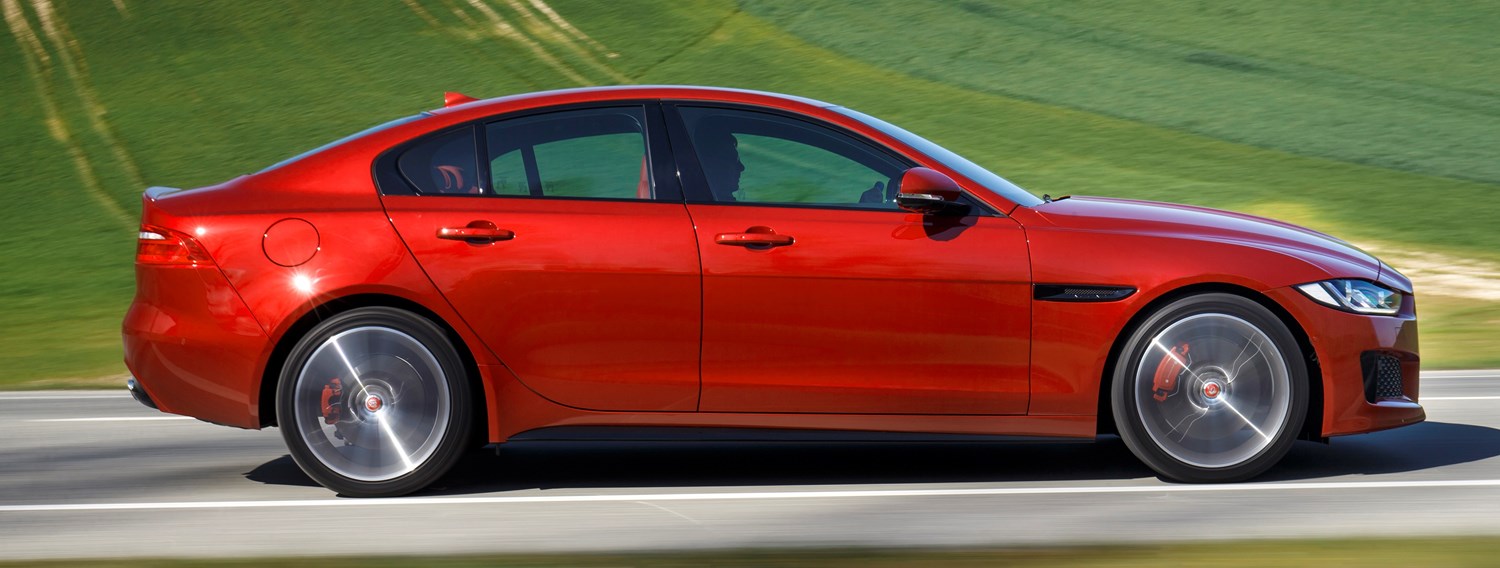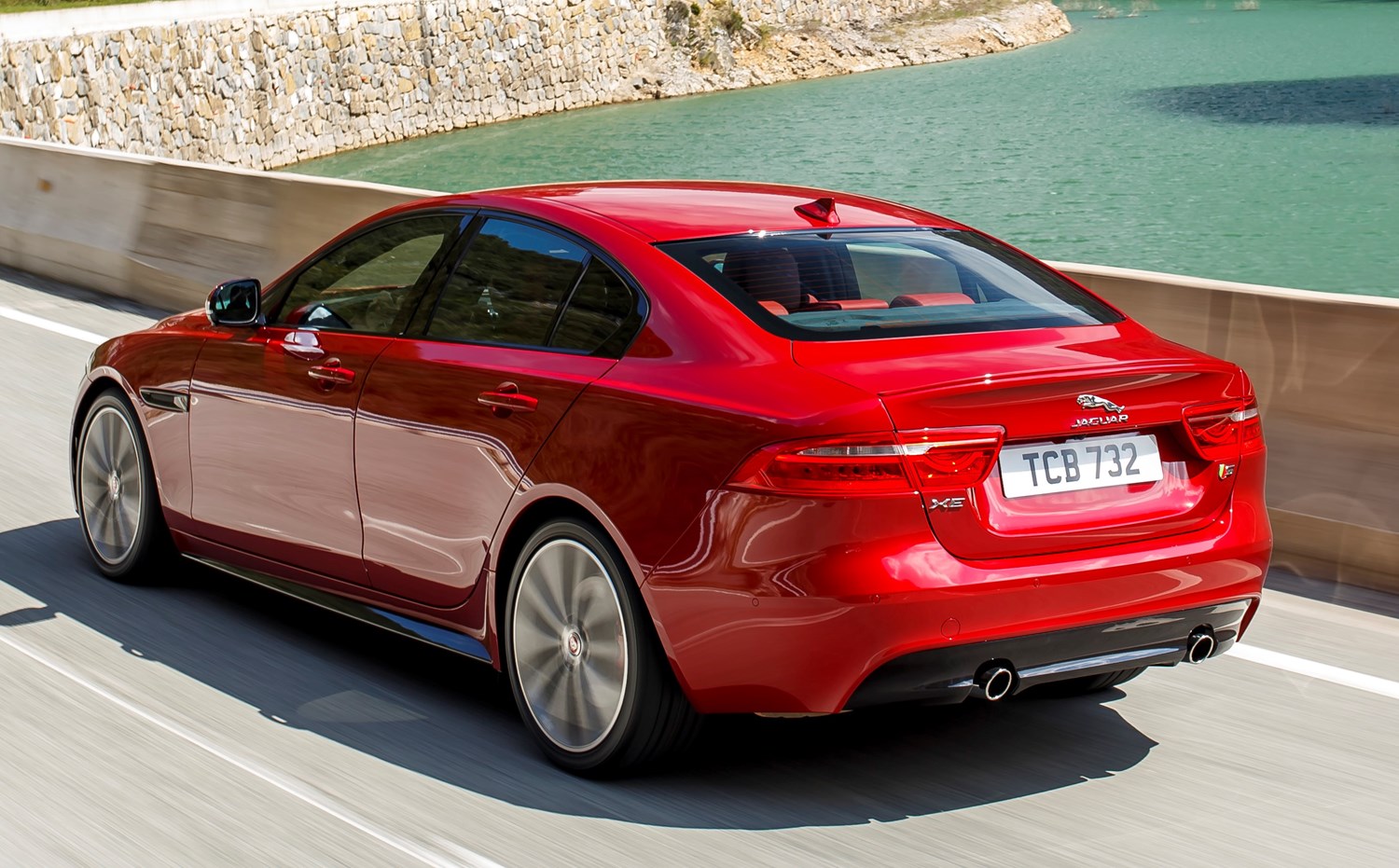Model Review
As a replacement for the X-Type, the XE didn’t have to do a terribly large amount of work to be more attractive than its predecessor, which definitely wasn’t styled for the 21st Century.
This fresh model was first unveiled in 2014 and with its muscular looks the XE was a much more appealing prospect when compared to its established German rivals.
It first went on sale in 2015 and it is fair to say it wowed the critics straight out of the gate and was considered a real contender in the executive saloon category as soon as it hit the forecourt.
With sporty looks, reliable and efficient Ingenium diesel engines – which are produced in conjunction with Land Rover – and great overall performance in the real world, what’s not to like about Jaguar’s baby saloon.
Latest Model
As the first model to be built at JLR’s Solihull plant in 2015, the XE was the fourth model to be styled in Jaguar’s new ethos with a much sportier façade.
Coming in five trim levels – three luxury and two sporty – the XE does span a lot of the executive saloon market and takes on the BMWs, Mercedes and Audis of the sector in a big way.
In what is a hotly contested market, Jaguar had to make the XE as appealing to younger professionals as possible and with the excellent styling, they’ve done just that and it has an air of cool about it.
With JLR’s Special Vehicle Operations creating a brutish and unroadworthy special edition called the Project 8, the XE has appeal in the younger market, which is exactly what Jaguar wanted.
Value for money
As Jaguar models go, the XE in SE spec is probably the least luxurious one you can buy. But that’s a bit harsh to say considering the fact that it is a Jaguar, so you still get premium fabric seats, eight-inch touchscreen with infotainment system including Jaguar InControl apps, satellite navigation, Bluetooth with audio streaming, dual-zone climate control and cruise control with speed limiter, as well as a host of safety systems including autonomous emergency braking and lane departure warning.
So even as the cheapest Jaguar, you get the premium feel and accessories you would expect from a brand of Jaguar’s stature and the SE range starts from £28,295.
Due to the model’s release being just two years ago, the likelihood of finding high spec options at a cheaper price than SE is only possible if they are a) in bad condition or b) has been written off at some point in its short life. But as the starting price for a new XE S is £48,045, finding one for £33,000 is quite simple to do.
Considering the supercharged 3.0-litre V6 petrol engine under the bonnet produces 335bhp and gets the car from 0-60mph in 4.9 seconds, that is a potent combination and could be well worth the money.
One 2015 example comes in a matte British racing green and has only covered 12,315, with accessories such as 19-inch alloys, red brake calipers, sport leather seats, S bodykit, full speaker system, adaptive dynamics and a powered boot lid. Even though it costs more than the SE, the relative affordability of the power and accessories available in the XE S is well worth it.
Looks and image
As a new model, Jaguar had a blank canvas to restart their small executive line and using the design ethos used for the XJ, F-TYPE and XF, the XE fits into the handsome and modern line-up superbly well.
The squared grille, well-thought out exterior proportions and short back end make this a great alternative – in terms of looks at least – to the German monopoly of the executive saloon market.
The interior is also well-designed as everything is intelligently placed, is well-refined and everything is placed where you would expect it to be. There are good options in the interior trim department, as well as LED mood lights placed throughout the cabin.
With a new lightweight aluminium chassis and adaptive dynamic suspension, the XE is right up there when compared to its rivals when you’re behind the wheel.
Its fast steering, rear-wheel drive setup and excellent suspension gives you good standing on pretty much any road surface, and with the help of tech, such as torque vectoring by braking – which uses the brakes on the inside wheels whilst cornering to give you a better turn in – and configurable dynamics, you get a great feel while driving the XE and makes it a true competitor to the BMW 3 Series.
When you aren’t going hell-for-leather on an A or B-road, it is a comfortable cruiser with the multi-link suspension and when you turn up the heat it is excellently balanced. One criticism is the diesel and manual engine/gearbox combinations, which can feel a bit disjointed at times and can lack that oomph many may look for.
The aforementioned suspension is angled towards comfort in the luxury models, which gives an excellent ride on most surfaces and it even floats over most potholes without any sign of being unsettled.
The R-Sport and S models come with a much firmer sports suspension, which can feel very firm indeed and for the day-to-day it’s probably worth going for one of the comfort models, especially if long journeys are a regularity for you. Interior comfort is good for the driver and front passenger, who have plenty of space, but rear space is the major downside of the XE as for an executive saloon it can feel a bit cramped in the back, which could push people towards the BMW 3 Series and Audi A4.
Space and practicality
The sloping roof line can limit head room for taller passengers in the back seats and rear legroom can be limited also, so it is recommended that you look elsewhere if you will be ferrying people around regularly. That isn’t to say it isn’t comfortable, it’s just that there are more spacious compact executive saloons.
In storage terms the XE does rather well considering its dimensions, with the boot space only slightly smaller than the class-leading Audi A4 at 455 litres. There are storage bins around the cockpit but are quite small, which is fair considering the size of the XE but can feel slightly impractical at times.
With the excellently designed aluminium chassis and high quality safety systems the XE comes with a five-star EuroNCAP rating and passed all of the organisation’s safety categories with at least an 80 per cent score, which is mightily impressive.
With anti-lock brakes, ESC, torque vectoring and the optional – but not necessarily needed in the UK – four-wheel drive coming with all surface progress control, which helps find grip on trickier surfaces. Other features such as lane-keeping assist and blind-spot assist are available at higher trims.
Despite the lack of an estate version, families should be excited by the excellent safety rating, high level of comfort and great features on offer, including three Isofix fixture points on the rear seats for child seat and other apparatus. Although the boot isn’t exactly cavernous, there’s plenty of storage space still and you will find it can be a great everyday car with a diesel engine and automatic gearbox.
Engines
Jaguar offers six power options – three diesel and three petrol – and all get an extra oomph from either a turbo or supercharger. All three diesel units come in the shape of a 2.0-litre, turbocharged four-cylinder block with power options of 160bhp, 177bhp and the top end 236bhp – which offers a top speed of 155mph and a 0-60mph time of 5.8 seconds, as well as an impressive return of 54.4mpg for an engine of its respective performance.
The three petrol units include two 2.0-litre, four-cylinder turbo options – with states of tune of 197bhp and 246bhp – and a 3.0-litre supercharged V6 with 374bhp at its disposal, which is the most potent of the range and only comes in the XE S.
Running costs
With all the diesel options, running costs are pretty good when compared to its real-life performance. The smallest 160bhp diesel feels underpowered in real terms but returns 75mpg with the manual gearbox and emits only 99g/km CO2 – which is excellent. But for the best of both worlds – performance and economy for long-distance cruisers – the mid-range 177bhp option is best, with returns of 67.3mpg and 109g/km CO2 without the all-wheel drive system in place.
For road tax, the lowest cost is for the 160bhp diesel as it is £120 for the first year, while the highest cost is for the XE S as it emits 194g/km CO2 and costs over £40,000, which means an overall first year cost of £1,510 for tax.
Thereafter it would cost £450 for the following four years, while the rest of the range would cost £140. Insurance groups range from group 22 for the least powerful models, up to group 36 for the XE S, making it quite an expensive runner.
Things to look out for
In its short life on the roads, only minor issues have befallen the XE and they have mainly been in combination with other Jaguar models. Seat belt pre-tensioner issues that came at the start of 2016 and the risk of engines cutting out in some diesel units that were also fitted to the XF saloon. Overall it has done very well, but if you’re looking at used models it is always worth checking their history just in case.
Rivals
The XE is in a very competitive sector alongside some of the best cars currently on British roads – in day-to-day conditions of course. The BMW 3 Series, Audi’s A4 and the latest upstart on the scene, Alfa Romeo’s Giulia, as well as the Mercedes C-Class, showing just how packed this sector is with great cars.
Not to mention the Lexus IS and Infiniti Q50 – which aren’t quite up to the same standard – that add an extra dimension to the market, you see how good the Jaguar XE has to be to stay competitive and ahead of the curve.
Depreciation warning
Although it is a bit soon to get an accurate representation of where XE models will be after three years, it is fair to say that XE models will hold on to around 45 per cent after 36,000 miles, which is around the market average.




